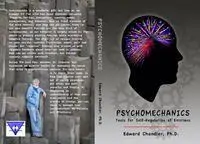By Edward Chandler, Ph.D.

BOOK DESCRIPTION:
Consciousness, like existence itself, is such a wonderful gift, but how do we manage it? We can easily get stuck in the weeds, trapped by negative emotions that ruin our day, or even our relationships. Feelings are the Holy Grail of consciousness, as we are largely driven to produce positive feelings, while minimizing negative ones. But “negative” emotions also provide us with valuable feedback about our needs. How can we use such feedback, but prevent runaway negative emotions? My task in Psychomechanics is to provide you with a toolkit of strategies for managing and benefiting from a variety of difficult feelings. The short list includes guilt and shame, sadness (and depression), frustration and anger, and anxiety.
I start by discussing some global personality issues that contribute to the bottom line of emotional satisfaction. I present a three-layer view of personality structure centered on needs, desires, and expectations, the negative feelings that result when these are blocked, and the defenses and coping strategies used to manage such feelings. It is important to distinguish between defenses (which have immediate benefits with a later price tag) and coping strategies (which are more difficult, but ultimately beneficial). I also tout the wisdom of vulnerability, at least selective vulnerability, because much of our negative behavior and conflicts (think of anger) involves attempts to avoid vulnerability. Another chapter addresses the meaning of “craziness,” and the often-subjective criteria for mental normalcy. I also look at the meaning of “stress,” the physiological components of emotion, and the interaction of mind and body. Then we get into the weeds, exploring the foundation of specific negative emotions – how to understand them, benefit from them, and prevent them from metastasizing into runaway trains. How can we allow ourselves to feel the inevitable negative feelings in life, and use them wisely, without becoming emotional train wrecks? How do we self-correct in the midst of madness?
If we look separately at thoughts, feelings, and behaviors, which is the most difficult to immediately change? The answer is feelings, right? Because we can only change feelings indirectly, by first changing thoughts or behaviors. Thus, it behooves us to understand what kinds of negative thoughts and behaviors set us up for each negative feeling, and what corrective steps we can take. For example, “What if?” thinking sets up anxiety, withdrawal aggravates depression, expectations drive frustration, and blaming begets anger. Thus, we can use this knowledge to change our thinking and behavior, and thereby improve our emotional economy. The payoff for our relationships is substantial as well, and the quality of our attachments is crucial to happiness. I therefore devote a chapter to the importance of attachment, both internal (self-esteem, self-nurturance) and external (romantic and social attachment, as well as spirituality). Ending on a positive note, I discuss positive psychology, as it is important to generate positive feelings, not just minimize negative ones.
If you bought my previous book, you need not purchase this self-help selection. Nearly all of Psychomechanics is included as the third and final section of Beyond Atheism – A Secular Approach to Spiritual, Moral, and Psychological Practices. BA was intended for the growing minority who check the box, “spiritual but not religious.” This freestanding version of Psychomechanics is intended for those who are seeking a psychological self-help guide, without a spiritual or secular angle. Whichever version suits you, I hope it helps you along your road to self-enhancement and emotional well-being. Thanks for listening.
CHAPTER TITLES:
Chapter 1: A Structure of the Mind
Chapter 2: The Wisdom of Vulnerability
Chapter 3: Am I Crazy?
Chapter 4: Stress and Confusion
Chapter 5: Managing Guilt and Shame
Chapter 6: Sadness and Depression
Chapter 7: Anxiety and Avoidance Behavior
Chapter 8: Anger and Frustration
Chapter 9: Trauma Recovery
Chapter 10: Internal and External Attachment
Chapter 11: Positive Psychology
Available at Amazon.com in Print and as an e-Book.


